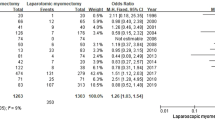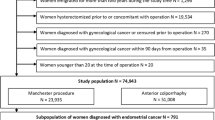Abstract
Purpose
The primary objective of our study was to investigate the effect of morcellation on overall survival in women with unsuspected uterine malignancy (UUM) diagnosed after myomectomy by comparing women who underwent laparotomic myomectomy to those who underwent laparoscopic myomectomy. The secondary objective was to estimate the incidence of UUM diagnosed after myomectomy.
Methods
We analyzed the mortality and incidence of women with UUM diagnosed after myomectomy using data from the national health insurance database between 2009 and 2013. To extract women with or without UUM diagnosed after myomectomy, we used diagnosis (C54.X) and procedure codes. We used the indicator of suspicion of death to verify deaths.
Results
During the study period, among the study population of approximately 23 million women per year, 102144 women underwent myomectomy. Of them, 69955 and 32085 women were enrolled onto the laparotomic and laparoscopic groups, respectively. In each group, the numbers of women with UUM diagnosed after myomectomy were 76 and 50, respectively. The incidences of UUM and UUM excluding endometrial cancer, respectively, were 0.1, 0.15 % (p = 0.046) and 0.05, 0.07 % (p = 0.147) in each group, respectively. The overall 3-year survival rates for patients with UUM and UUM excluding endometrial cancer were 97.6 ± 0.2 % (n = 23), 91.5 ± 0.5 % (n = 12); and 93.8 ± 0.6 % (n = 8), 93.8 ± 0.6 % (n = 5) in each group, respectively. Additionally, there were no statistically significant differences between the groups with respect to overall survival of women with UUM with or without endometrial cancer (log-rank test; p = 0.14) (time-dependent Cox regression model; p = 0.93).
Conclusions
There was no difference in the overall survival of women with UUM with or without endometrial cancer between groups. The incidence of UUM with or without endometrial cancer diagnosed after myomectomy was quite low.


Similar content being viewed by others
References
Khan AT, Shehmar M, Gupta JK. Uterine fibroids: current perspectives. Int J Womens Health. 2014;6:95–114.
Bhave Chittawar P, Franik S, Pouwer AW, Farquhar C. Minimally invasive surgical techniques versus open myomectomy for uterine fibroids. Cochrane Database Syst Rev. 2014;10:CD004638.
US Department of Health and Human Services; US Food and Drug Association. UPDATED laparoscopic uterine power morcellation in hysterectomy and myomectomy: FDA Safety Communication. Available at: http://www.fda.gov/medicaldevices/safety/alertsandnotices/ucm424443.htm.
AAGL Advancing Minimally Invasive Gynecology Worldwide. AAGL practice report: morcellation during uterine tissue extraction. J Minim Invasive Gynecol. 2014;21:517–30.
Kim L, Kim JA, Kim S. A guide for the utilization of Health Insurance Review and Assessment Service National Patient Samples. Epidemiol Health. 2014;36:e2014008.
Kim L. The indicator of suspicion of death. Personal communication.
Wright JD, Tergas AI, Burke WM, et al. Uterine pathology in women undergoing minimally invasive hysterectomy using morcellation. JAMA. 2014;312:1253–5.
Takamizawa S, Minakami H, Usui R, et al. Risk of complications and uterine malignancies in women undergoing hysterectomy for presumed benign leiomyomas. Gynecol Obstet Invest. 1999;48:193–6.
Seidman MA, Oduyebo T, Muto MG, Crum CP, Nucci MR, Quade BJ. Peritoneal dissemination complicating morcellation of uterine mesenchymal neoplasms. PloS One. 2012;7:e50058.
Parker WH, Fu YS, Berek JS. Uterine sarcoma in patients operated on for presumed leiomyoma and rapidly growing leiomyoma. Obstet Gynecol. 1994;83:414–8.
Leibsohn S, d’Ablaing G, Mishell DR, Schlaerth JB. Leiomyosarcoma in a series of hysterectomies performed for presumed uterine leiomyomas. Am J Obstet Gynecol. 1990;162:968–74.
Kamikabeya TSF, Etchebehere RM, Nomelini RS, Murta EFC. Gynecological malignant neoplasias diagnosed after hysterectomy performed for leiomyoma in a university hospital. Eur J Gynaecol Oncol. 2010;31:651–3.
Yuk JS, Ji HY, Lee SH, Park YS, Lee JH. Unexpected uterine malignancy in women who have undergone myomectomy. Int J Gynaecol Obstet. 2015;129:270–1.
George S, Barysauskas C, Serrano C, et al. Retrospective cohort study evaluating the impact of intraperitoneal morcellation on outcomes of localized uterine leiomyosarcoma. Cancer. 2014;120:3154–8.
Park JY, Park SK, Kim DY, et al. The impact of tumor morcellation during surgery on the prognosis of patients with apparently early uterine leiomyosarcoma. Gynecol Oncol. 2011;122:255–9.
Morice P, Rodriguez A, Rey A, et al. Prognostic value of initial surgical procedure for patients with uterine sarcoma: analysis of 123 patients. Eur J Gynaecol Oncol. 2003;24:237–40.
Stovall TG, Photopulos GJ, Poston WM, Ling FW, Sandles LG. Pipelle endometrial sampling in patients with known endometrial carcinoma. Obstet Gynecol. 1991;77:954–6.
Zorlu CG, Cobanoglu O, Işik AZ, Kutluay L, Kuşçu E. Accuracy of pipelle endometrial sampling in endometrial carcinoma. Gynecol Obstet Invest. 1994;38:272–5.
Kassebaum NJ, Bertozzi-Villa A, Coggeshall MS, et al. Global, regional, and national levels and causes of maternal mortality during 1990–2013: a systematic analysis for the Global Burden of Disease Study 2013. Lancet. 2014;384(9947):980–1004.
McPherson K, Metcalfe MA, Herbert A, et al. Severe complications of hysterectomy: the VALUE study. BJOG Int J Obstet Gynaecol. 2004;111:688–94.
Varol N, Healey M, Tang P, Sheehan P, Maher P, Hill D. Ten-year review of hysterectomy morbidity and mortality: can we change direction? Aust N Z J Obstet Gynaecol. 2001;41:295–302.
Juillard C, Lashoher A, Sewell CA, Uddin S, Griffith JG, Chang DC. A national analysis of the relationship between hospital volume, academic center status, and surgical outcomes for abdominal hysterectomy done for leiomyoma. J Am Coll Surg. 2009;208:599–606.
Acknowledgments
We thank Yun Kyung Kang, Department of Medical Records, MizMedi Hospital.
Disclosure
The authors declare no conflict of interest.
Author information
Authors and Affiliations
Corresponding author
Rights and permissions
About this article
Cite this article
Yuk, JS., Ji, H.Y., Shin, JY. et al. Comparison of Survival Outcomes in Women with Unsuspected Uterine Malignancy Diagnosed After Laparotomic Versus Laparoscopic Myomectomy: A National, Population-Based Study. Ann Surg Oncol 23, 1287–1293 (2016). https://doi.org/10.1245/s10434-015-4976-3
Received:
Published:
Issue Date:
DOI: https://doi.org/10.1245/s10434-015-4976-3




